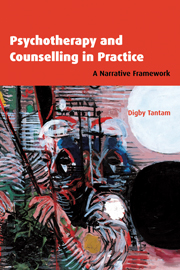Book contents
- Frontmatter
- Contents
- Preface
- A note on terminology
- Acknowledgements
- Introduction
- 1 Establishing the concerns
- 2 Values
- 3 What life means. Emotional flavour
- 4 Narrating the treatment: the formulation, reformulation and therapeutic contract
- 5 Narrating the self
- 6 Procedures for gaining relief
- 7 Resolution: finding out what's doing this to me
- 8 Universal technique for resolving predicaments
- 9 Relinquishment and releasement: changing something about me
- 10 Re-narration: finding happiness
- 11 Crises, and how to surmount them
- Appendix: confidential record
- References
- Index
3 - What life means. Emotional flavour
Published online by Cambridge University Press: 06 November 2009
- Frontmatter
- Contents
- Preface
- A note on terminology
- Acknowledgements
- Introduction
- 1 Establishing the concerns
- 2 Values
- 3 What life means. Emotional flavour
- 4 Narrating the treatment: the formulation, reformulation and therapeutic contract
- 5 Narrating the self
- 6 Procedures for gaining relief
- 7 Resolution: finding out what's doing this to me
- 8 Universal technique for resolving predicaments
- 9 Relinquishment and releasement: changing something about me
- 10 Re-narration: finding happiness
- 11 Crises, and how to surmount them
- Appendix: confidential record
- References
- Index
Summary
Just as we swallow food because we like it not because of its nutritional content, so do we swallow ideas because we like them and not because of their rational content
(Asher, 1972)This chapter sets out in more detail the third of the four ruling ideas in this book. Concerns and value have already been considered. The next two chapters deal with narrative. This chapter deals with what might be less familiar concepts, emotions and emotional flavours, and emotional meanings.
An emotional flavour is the capacity for something, a familiar object or a close other person for example, to induce a particular emotion in us. I shall call the something an emotor to avoid having to spell out all the different things that can induce an emotion. Emotors induce emotions without going through the appraisal stage. They plug straight into the emotion brain. They acquire their emotive capacity by associative learning, and I shall give examples of this below, but we experience them as having this capacity inherent in them. If I see a body, covered in blood, lying on the road, I might think, ‘a road traffic accident’, and I may start to work out how I feel about stopping to help, but long before that, I will have felt horror, fear, compassion and other more idiosyncratic emotions.
- Type
- Chapter
- Information
- Psychotherapy and Counselling in PracticeA Narrative Framework, pp. 55 - 80Publisher: Cambridge University PressPrint publication year: 2002



